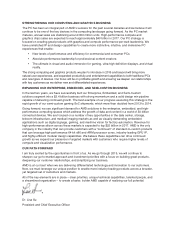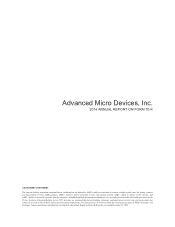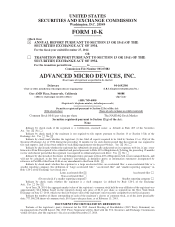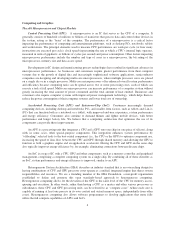AMD 2014 Annual Report Download - page 13
Download and view the complete annual report
Please find page 13 of the 2014 AMD annual report below. You can navigate through the pages in the report by either clicking on the pages listed below, or by using the keyword search tool below to find specific information within the annual report.PCs include the AMD Radeon R7 and R9 series, AMD Radeon HD 8000 series, AMD Radeon 7000 series and
AMD Radeon HD 6000 series. In February 2014, we introduced two new additions to the R7 series—the AMD
Radeon R7 250X and R7 265. In March 2014, we added the AMD Radeon R9 280 to the R9 Series, and more
recently in April 2014, we introduced the AMD Radeon R9 295X2, powered by two AMD Radeon R9 295 GPUs
on a single card designed for gamers and PC enthusiasts. All models of our AMD Radeon R7 and R9 series
graphic cards support our Mantle API.
Discrete Notebook Graphics. Our discrete GPUs for notebooks are designed to address graphics
performance, visual experience, power efficiency, dedicated memory support and ease of design integration, all
of which are key considerations for notebook manufacturers. The AMD lineup of discrete GPUs for notebooks
includes the AMD Radeon HD 7000M series and AMD Radeon HD 6000M series. In January 2014, we
introduced the AMD Radeon R9, R7 and R5 M200 Series, our new family of discrete GPUs for notebooks
designed with support for Mantle API.
Professional Graphics. Our AMD FirePro™ family of professional graphics products consists of 3D and
2D multi-view graphics cards and GPUs that we designed for integration in mobile and desktop workstations, as
well as commercial PCs. We designed our AMD FirePro 3D graphics cards for demanding applications, such as
those found in the computer aided design (CAD) and digital content creation (DCC) markets, with drivers
specifically tuned for maximum performance, stability and reliability across a wide range of software packages.
We designed our AMD FirePro 2D graphics cards with dual- and quad-display outputs for financial and
corporate environments.
We also provide the AMD FirePro S-Series GPU products for the server market, where we target high
performance computing (HPC) and virtual desktop infrastructure (VDI) use cases. In April 2014, we launched
the AMD FirePro W9100 professional graphics cards for next-generation workstations with ultra-high resolution
and multi-display capabilities. In June 2014, we launched the AMD FirePro W8100 professional graphics card
designed for the next generation 4K CAD and media and entertainment workflows, engineering analysis and
supercomputing applications. In August 2014, we introduced new additions to the next generation AMD FirePro
professional graphics family, the AMD FirePro W2100, AMD FirePro W4100, AMD FirePro W5100 and AMD
FirePro W7100. Additionally, we announced the AMD FirePro S9150 Server GPU in August 2014, designed for
large scale multi-GPU support and the AMD FirePro S9100 in October 2014, designed for high visualization,
high throughput and multi-tasking.
Enterprise, Embedded and Semi-Custom
The Enterprise, Embedded and Semi-Custom Markets
Server. A server is a computer system that performs services for connected customers as part of a client-
server architecture. Many servers are designed to run an application or applications often for extended periods of
time with minimal human intervention. Examples of servers include web servers, e-mail servers and print
servers. These servers can run a variety of applications, including business intelligence, enterprise resource
planning, customer relationship management and advanced scientific or engineering models to solve advanced
computational problems in disciplines ranging from financial modeling to weather forecasting to oil and gas
exploration. Servers are also used in cloud computing, which is a computing model where data, applications and
services are delivered over the internet or an intranet. Today’s data centers require new technologies and
configuration models to meet the demand driven by the staggering amount of data that needs to be stored,
accessed and managed. Servers must be efficient, scalable and adaptable to meet the compute characteristics of
new and changing workloads.
Embedded.Embedded products address computing needs in PC-adjacent markets, such as industrial
control and automation, digital signage, point of sale/self-service kiosks, medical imaging, set-top box and casino
gaming machines as well as enterprise class telecommunications, networking, security, storage systems and “thin
clients” (which are computers that serve as an access device on a network). Typically, our embedded products are
used in applications that require high to moderate levels of performance, where key features may include
7
























